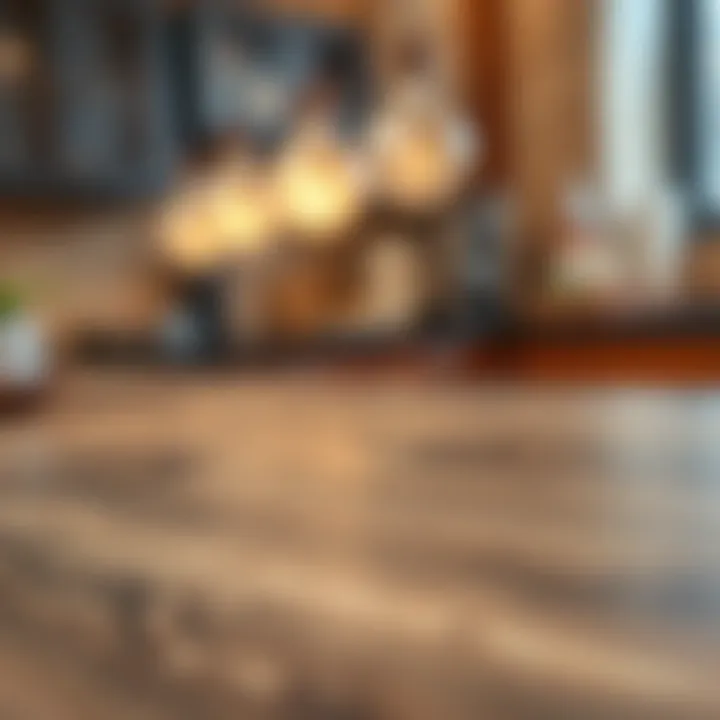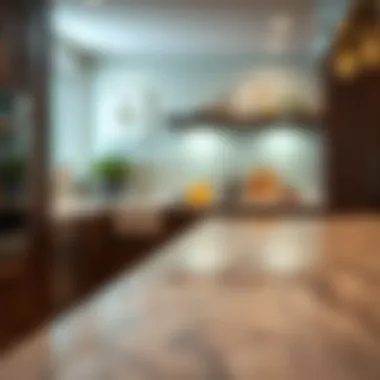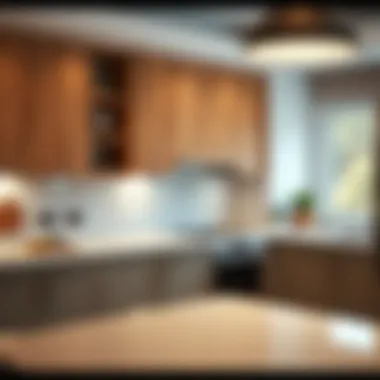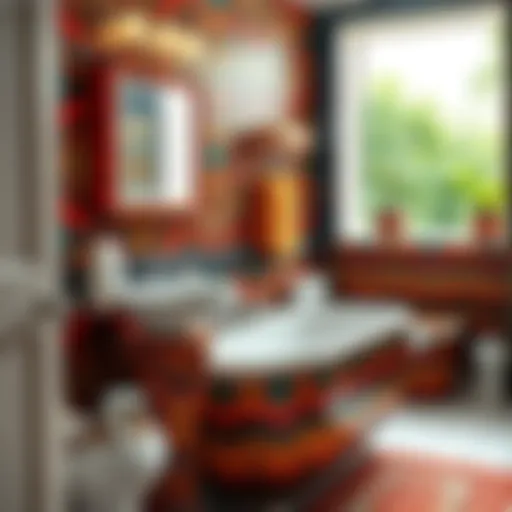Durable Laminate Countertops: A Complete Overview


Intro
In today’s rapidly evolving design landscape, the quest for durability and style often leads homeowners toward laminate countertops. These surfaces have made a significant splash in the market, emerging as a go-to choice for many seeking a blend of aesthetics and functionality in their kitchens and bathrooms. This guide aims to shed light on the multifaceted world of durable laminate countertops—what they are, how they are made, and the myriad benefits they offer.
Laminate countertops are not merely affordable alternatives to natural stones or solid woods. They’re innovative, practical solutions that excel in withstanding the rigors of daily life. Whether you’re an experienced interior designer or a keen DIY enthusiast, understanding the construction, advantages, and maintenance of these surfaces is essential. As we delve deeper, this article will also showcase the design versatility that laminate countertops offer, giving you insights to make an informed decision.
Let’s embark on this journey together, exploring the robust features of laminate countertops that help them stand the test of time in both style and function.
Furniture Styles and Trends
Modern vs. Traditional: Understanding the Aesthetics
When it comes to countertops, design is king. Modern laminate countertops can hold their own against both trendy and traditional styles. The beauty of laminate lies in its ability to mimic other materials while still being remarkably durable. From sleek, shiny surfaces to matte finishes that evoke a rustic charm, there’s a style for everyone.
For those leaning towards modern aesthetics, options like geometric patterns and bold colors have become popular. They provide a striking contrast to the minimalist décor often seen today. Conversely, traditional styles might favor wood finish laminates that lend warmth and comfort to a space. This adaptability allows homeowners to explore various looks without compromising on durability.
Think about the space you want to enhance. Are you creating a contemporary kitchen that calls for something edgy or a cozy family space that thrives on warmth? Laminate covers the spectrum and can be tailored to fit any vision.
Color and Material Trends: What's In and What's Out
In terms of colors, neutrals remain perennial favorites, but we see a growing trend toward bolder hues making a comeback. Rich blues, deep greens, and vibrant reds can invigorate your space and add personality. Materials are also evolving, with laminates incorporating textures that mimic the tactile quality of natural stone or even concrete, enhancing the overall experience.
"A kitchen isn’t just a place to cook; it’s a canvas for your creativity. Durable laminate surfaces give you that freedom."
Anonymous Interior Designer
This shift towards embracing color and texture in laminate countertops is a game-changer in how homeowners think about design. Brands are continuously innovating, providing a plethora of options that cater to varying tastes and preferences. Don't hesitate to explore these trends; they can breathe fresh life into your home.
Furniture Care and Maintenance
Tips for Prolonging the Life of Your Furniture
Maintaining laminate countertops might not be rocket science, but a few key practices can extend their lifespan remarkably. Here are some effective tips:
- Clean Regularly: Use a damp cloth and a mild detergent to wipe down the surfaces regularly. Avoid harsh chemicals that can damage the laminate.
- Use Cutting Boards: While laminate is durable, it’s still wise to use cutting boards to prevent scratches and cuts.
- Avoid Hot Items: Never place hot pots directly onto laminate. Instead, use trivets to shield the surface from heat, preventing warping and discoloration.
These small habits can significantly enhance the durability and appearance of your laminate countertops, ensuring they look good as new for years to come.
DIY Repair Hacks for Common Furniture Issues
Even the best cared-for countertops might suffer occasional mishaps. Thankfully, minor imperfections can often be addressed with some DIY know-how:
- Small Scratches: Use a color-matched repair marker to fill in small scratches, giving them a fresh look.
- Stains: For stubborn stains, a mixture of baking soda and water can work wonders. Just apply it, let it sit for a short while, and then wipe off.
- Gluing: If seams start to separate, using a strong waterproof glue will set things right without calling for professional help.
These tips provide quick fixes that let you handle common issues before they become major headaches. A little effort goes a long way in nurturing your laminate surfaces.
In summary, durable laminate countertops are much more than a functional surface; they are a design statement that can enhance any space. With the right choices, maintenance, and a touch of creativity, these counters can serve both practical and aesthetic purposes beautifully.
Prolusion to Laminate Countertops
When it comes to countertops, laminate surfaces have gained a reputation as a practical and stylish choice. They strike a balance between functionality and aesthetics, wowing both homeowners and designers alike. In this segment, we’ll dive into laminate countertops: what they are, how they fit into modern homes, and why they deserve your attention.
Understanding Laminate Material
To fully appreciate the benefits of laminate countertops, let's first break down what laminate material actually is. Laminate is a composite material, primarily made of layers of paper or fabric that are saturated with resin. These layers are bonded together under high heat and pressure, resulting in a sturdy surface that’s both versatile and dependable.
The beauty of laminate lies not just in its durability but also in its ability to mimic other materials, such as granite or wood, at a fraction of the cost. With advancements in technology, today’s laminate can showcase a variety of textures and finishes that look remarkably close to their natural counterparts.
Additionally, laminate surfaces can be produced in a plethora of colors, making them adaptable to different design schemes. Whether a home leans toward contemporary finesse or rustic charm, laminate can be tailored to meet those needs.
Historical Context of Laminate Usage
The journey of laminate countertops is interesting, rising to prominence in the postwar era when the need for affordable and efficient building materials surged. The late 1940s and 1950s marked a turning point, as laminate gained traction in American kitchens as a decorative yet functional surface. Initially perceived as a material for the middle class, laminate transformed spaces with its array of vibrant colors and patterns that could brighten up any room.
As the decades rolled by, laminate continued to evolve, shedding its initial stigma as merely budget-friendly. Designers and homeowners began to embrace its low maintenance and adaptable nature. Nowadays, it’s not uncommon to see laminate in high-end spaces, thanks to innovations that enhance its appeal.
Emerging from a historically undervalued position, laminate countertops have now solidified their standing as a go-to for many home renovations or new builds. They reflect both practicality and aesthetic sensibility, making them a choice that meets various lifestyle needs.
Construction and Composition
Understanding the construction and composition of laminate countertops is vital in appreciating their functionality and aesthetic appeal. This section delves into the intricate layers that make up laminate surfaces, shedding light on how their design contributes to durability and overall performance in everyday use. With knowledge of these elements, homeowners, designers, and DIY enthusiasts can make informed decisions about selecting countertops that best suit their needs.
Layers of Laminate
Base Layer
The base layer is the unsung hero of laminate countertops. Typically made from high-density fiberboard or particleboard, this layer provides the foundational strength and stability necessary to support the weight above it. One key characteristic of the base layer is its ability to resist warping, which can be a significant issue in areas with varying humidity levels.
One unique feature of the base layer that stands out is its moisture resistance capability. This trait makes it a beneficial choice for kitchen and bathroom applications where spills and splashes occur frequently. However, if not properly sealed, it can be susceptible to water damage over time, potentially compromising the countertop's integrity. Thus, ensuring proper care and sealing of this part is essential to maximize its longevity.
Decorative Layer
Above the base lies the decorative layer, which brings the countertop to life. Made from printed paper or other design materials, this layer dictates the appearance of the laminate countertop. It gives the surface its visual charm, allowing for a vast array of colors, textures, and patterns. This flexibility is one reason why laminate surfaces are favored in various design settings.


What makes the decorative layer interesting is the precision with which designs can be printed. Modern techniques enable intricate patterns, mimicking natural stone or wood grains convincingly. However, a trade-off exists; while the decorative layer is visually appealing, it can be more prone to wear and fading under heavy use or exposure to direct sunlight. Maintaining its integrity may involve periodic cleaning and avoiding abrasive materials that might damage its finish.
Protective Layer
Finally, the protective layer plays a crucial role in ensuring the longevity of laminate countertops. This layer is often composed of a clear resin finish that shields the decorative layer from scratches, stains, and heat. The key characteristic here is the resilience it provides, allowing laminate surfaces to endure daily wear and tear with ease.
A distinctive feature worth noting is the anti-microbial properties that some modern protective layers possess. This innovative addition can help keep countertops hygienic, especially in food preparation areas. Yet, it's important to understand that while this layer provides robust protection, it cannot make the countertops impervious to damage. Users still need to exercise caution with hot cookware or sharp utensils to prolong the lifespan of the countertop.
Manufacturing Process
Raw Material Sourcing
The quality of laminate countertops starts with raw material sourcing. The materials, often derived from sustainable forests, contribute not just to the durability but also to the overall environmental footprint of the product. A standout aspect is the increasing trend towards eco-friendly sourcing practices that many manufacturers have adopted, reducing their impact on the environment.
However, balancing sustainability with quality can be a challenge. Some manufacturers may prioritize cost over careful sourcing, influencing the final product's durability and appeal. For consumers interested in eco-friendly options, it’s essential to look for certifications indicating sustainable practices in sourcing.
Pressing Techniques
Next in the manufacturing chain is pressing techniques, which determine the physical properties of the laminate. Hot pressing or cold pressing methods are commonly employed, each providing different advantages in terms of strength and finish. Hot pressing generally leads to a denser and more durable product, while cold pressing might be more suited for intricate designs that require delicate handling.
An intriguing aspect of modern pressing techniques involves the use of digital patterns, enabling manufacturers to create high-definition prints that elevate visual aesthetics. However, reliance on specific techniques can also limit the production batch sizes, affecting availability and cost. Buyers should be aware of these nuances when selecting laminate countertops, as they can significantly impact both the product's performance and price.
Curing Methods
Finally, the curing methods solidify the countertop's properties. Depending on the method used—thermoplastic curing or curing with adhesives—each contributes differently to the countertop's durability and usability. Thermoplastic curing often leads to better flexibility and impact resistance, while adhesive curing can bulk up the layer structure, enhancing stability.
> Curing methods are pivotal; without them, the reliability of laminate countertops might falter, leading to early wearing or damage.
Overall, understanding the manufacturing process helps consumers make wiser choices while also appreciating the intricacies involved in creating durable laminate countertops. Each layer and method plays a role in ensuring that laminate countertops not only look good but endure the rigors of everyday life.
Advantages of Durable Laminate Countertops
The advantages of durable laminate countertops are numerous and significant, making them a top choice for homeowners, designers, and DIY enthusiasts alike. When you weigh the options, laminate surfaces shine through with their versatility and resilience, addressing both functional and aesthetic needs. Here, we'll explore various aspects that underscore their popularity in modern design, from cost-effectiveness to maintenance ease.
Cost-Effectiveness
One of the most compelling reasons to consider laminate countertops is their cost-effectiveness. In today’s economy, budget-friendly options are a must, and laminate delivers without skimping on style or performance. Generally, laminate surfaces are substantially cheaper than natural stones like granite or quartz. This affordability makes them an attractive option for remodeling projects or new construction, particularly when multiple surfaces or larger areas need to be covered.
Additionally, the cost of installation tends to be lower. Many homeowners can embark on DIY installations, which further reduces expenses. With affordable options available that imitate high-end materials, such as wood and stone, it’s no wonder homeowners are opting for laminates. Not only does it keep money in your pocket, it allows you some creative freedom without breaking the bank—leaving room in the budget for other enhancements in your home.
Resistance to Wear and Tear
Durability is a hallmark of laminate countertops. These surfaces are engineered to resist wear and tear, making them ideal for busy kitchens and high-traffic areas. They have a robust construction that withstands regular use, which is particularly important for families, cooking enthusiasts, or anyone who simply uses their countertops frequently. Unlike some materials that can become scratched, chipped, or stained with daily use, laminate countertops maintain their look with minimal fuss.
Key characteristics include:
- Impact resistance: Laminate surfaces can tolerate knocks and bumps, safeguarding against unsightly dents.
- Stain resistance: The non-porous surface repels spills and stains, allowing for easy cleanup of accidents involving foods or drinks.
"Laminate countertops combine practicality with aesthetics, ensuring a long-lasting solution that doesn’t sacrifice style."
This advantage is pivotal for households wanting an attractive appearance without the anxiety associated with potential damage that can come with other materials.
Easy Maintenance
Another area where laminate countertops excel is in maintenance. In the fast-paced world many of us live in today, a simple care routine is essential. Laminate surfaces are notoriously easy to clean compared to stone; it generally takes just soap, water, and a cloth to keep them looking pristine. No special cleaners or treatments are required, saving time and effort.
Here’s what to keep in mind for easy upkeep:
- Daily cleaning: A quick wipe down with a damp cloth removes most spills.
- Deep cleaning: For more stubborn stains, use a diluted vinegar solution or a mild detergent.
Forget about the rigorous cleaning schedules often required by other materials. With laminate, you can enjoy your kitchen without a constant worry about its upkeep. Less maintenance means more time for cooking, entertaining, or just enjoying your space.
In summation, the benefits of durable laminate countertops stretch far beyond mere aesthetics. In terms of cost-effectiveness, resistance to damage, and easy maintenance, it is clear that laminate surfaces hold a strong appeal for a wide audience. These are not just functional work surfaces; they contribute to the overall style of your home while offering practical solutions to everyday challenges.
Design Versatility
Design versatility is a fundamental aspect of laminate countertops that makes them an attractive choice for homeowners and designers alike. This adaptability allows these surfaces to suit various aesthetics, from traditional to cutting-edge modern styles. The multitude of colors, textures, and patterns helps in tailoring a kitchen or bath—essentially creating a canvas upon which individual tastes can be expressed. No longer are laminate options seen as bland or outdated; today, they are a focal point in many spaces.
Color Options
When it comes to colors, laminate countertops offer a veritable rainbow of features. You can find hues ranging from earthy tones like browns and greens to vibrant reds and blues. This wide array can help harmonize your countertops with cabinets or appliances, creating a seamless look. Color choice also plays a big role in how light interacts with your space. Lighter shades can make a room appear larger, while darker tones introduce a sense of depth.
Texture and Finish Choices
The finish and texture of laminate countertops can greatly influence the overall appearance and functionality. These elements don't just serve aesthetic purposes; they can also play a role in the usability of the surfaces.
Glossy Finishes
Glossy finishes reflect light, adding a sense of brightness to the kitchen. Their sleek shine can highlight a range of colors, elevating the visual appeal. Another perk is the ease with which spills can be cleaned off; the smooth surface doesn’t allow dirt or grime to settle easily. However, one must be mindful as they can easily show fingerprints or smudges, requiring more frequent cleaning than other finishes.
Matte Finishes
On the flip side, matte finishes offer a sophisticated, understated look. They absorb light rather than reflecting it, creating a cozy atmosphere in the room. This finish does not show fingerprints as prominently, making it a more practical choice for a busy kitchen. However, it may not be as easy to wipe clean as its glossy counterpart. Oil or grease can cling more tightly, which could mean a bit more elbow grease is required during cleaning.
Textured Surfaces


Textured surfaces introduce a tactile element to laminate countertops that's hard to overlook. These designs can mimic the feel of natural stone or wood, allowing homeowners to achieve a high-end look at a lower cost. Textures can also hide minor scratches and dents better than shiny finishes, making them a sturdy option for households with children or pets. That said, attention to cleaning becomes crucial, as dirt can hide within the grooves.
Patterns and Styles
Patterns and styles in laminate countertops further broaden design possibilities. Whether it’s a subtle veining like that of marble or rich designs reminiscent of exotic woods, patterns can add layers of interest.
Selecting a bold pattern can serve as a statement piece that defines the kitchen or bathroom. Alternatively, homeowners may favor simpler designs that allow other elements in the space to take the spotlight.
With so many choices available, it’s crucial for anyone considering laminate countertops to take time selecting the right color, texture, and pattern. These decisions not only impact aesthetics but also performance, effectiveness, and the emotional tone set within the space.
Installation Techniques
When it comes to installing durable laminate countertops, the techniques you choose are as important as the material itself. A proper installation ensures not only aesthetic appeal but also the longevity and performance of the countertops. If everything's on the up-and-up during installation, you will enjoy a stunning and functional workspace for years to come. Plus, understanding the right techniques makes the process easier for both homeowners and DIYers.
Preparation Steps
Preparation is half the battle. Before diving into the installation, there are a few crucial steps you need to follow to set the stage properly:
- Measure Accuracy: Use a tape measure to get precise dimensions of your cabinets and the countertop edges. You want to avoid cutting too short or having gaps at the seams.
- Prepare the Workspace: Clear out the area. Ensure you have enough space where you're going to do the installation, which helps prevent potential hazards or mess-ups.
- Gather Materials: Gather all materials and check if everything’s in order. This includes adhesive, backer board, and any additional items, like a router or jigs.
Taking these steps makes the actual installation process flow more smoothly, reducing stress and increasing the likelihood of a successful setup.
Tools Required for Installation
Having the right tools is essential for a smooth and successful installation. Below is a list that covers the basics you will need:
- Jigsaw or Circular Saw: For cutting laminate sheets accurately.
- Router: To create a clean edge, especially for sinks and seams.
- Measuring Tape: Essential for ensuring accuracy in all cuts and placements.
- Clamps: Used to secure the laminate properly while the adhesive sets.
- Adhesive: Choose one specifically designed for laminate to ensure it bonds well.
- Screwdriver or Drill: If your installation requires securing to cabinets.
A well-stocked tool arsenal can make a world of difference. Without these, you might find yourself running off to the store mid-project—nobody wants that!
Step-by-Step Installation Process
Now let’s get to the meat and potatoes of the installation. Here’s a straightforward three-step process you can follow:
- Cutting the Laminate: Start with marking your laminate sheet. With precision, use a jigsaw or circular saw to cut it to your desired dimensions. Remember to make cuts slightly larger than measurements so you can trim it back for exact fits later on.
- Apply Adhesive: Once cut, lay the laminate upside down and spread a continuous line of adhesive on the bottom. Be liberal but not excessive to avoid oozing out the edges during placement.
- Secure and Position: Carefully flip the laminate and position it on the base. Use clamps to hold it in place for at least 20–30 minutes while it sets. If you’re routing edges or creating seam joints, make sure to follow those steps according to your preferred design.
"Measure twice, cut once." This old saying couldn’t be more accurate when it comes to laminate countertop installation. Double-check your measurements before each cut to avoid costly mistakes.
Following these steps will ensure that your installation is as seamless as possible, paving the way for a beautiful and robust surface that you can be proud of.
For more advanced techniques or if you run into specific challenges, consider checking community forums like Reddit or review professional installation videos on platforms such as YouTube for expert advice.
Care and Maintenance
Taking care of laminate countertops is crucial. These surfaces can withstand a fair amount of abuse, but they still require some love and attention to maintain their beauty and functionality. Having a solid understanding of proper care and maintenance can extend the lifespan of these countertops, keeping them looking fresh and vibrant in your kitchen or bathroom.
Cleaning Techniques
Cleaning laminate countertops is relatively simple. Typically, a damp cloth and mild soap can do the trick. Here are some effective cleaning methods:
- Daily Wipe-Down: Just a quick scrub with warm soapy water every day keeps grime at bay. Avoid harsh chemicals as they might scratch or dull the surface.
- Stain Removal: For tougher stains, you might need a bit more elbow grease. A paste made from baking soda and water can often lift stubborn stains. Apply it gently, let it sit for a while, and rinse it off.
- Disinfecting: From time to time, especially during flu season or after preparing raw food, it’s wise to disinfect the surfaces using a mixture of water and vinegar. Mix equal parts and spray it on, then wipe down with a dry cloth.
Preventing Damage
Heat Resistance
Heat resistance is a significant consideration when discussing laminate countertops. They generally offer moderate heat resistance, meaning they can endure hot pots and pans to a certain extent, but it isn't foolproof. It's always wise to use trivets or pot holders to protect the surface. The key characteristic of this heat tolerance is its ability to resist warping; however, overheating can still lead to unsightly burn marks or melting if a direct heat source is placed on them for too long. Hence, it's a good idea to treat your countertop with care, as utilizing proper placements can keep things looking sharp for years.
Scratch Prevention
Scratch prevention is essential for maintaining the aesthetic appeal of laminate countertops. The surfaces can be prone to scratches if abrasive materials are used during food preparation or heavy cleaning. A good practice is to employ cutting boards made from wood or plastic to alleviate this issue. This characteristic of preventive measures helps maintain both functionality and looks. By reducing the risk of scratches, homeowners keep their countertops in tip-top shape for whenever the next family gathering comes around.
"Investing time in care can save you money down the road—it's cheaper to maintain than to replace!"
With a bit of daily commitment to cleaning and preventative strategies, your laminate countertops will serve both practical uses and aesthetic pleasures for many years ahead.
Limitations of Laminate Countertops
While laminate countertops boast several advantages, it’s crucial to also address their inherent limitations. Understanding these constraints allows homeowners, designers, and DIY enthusiasts alike to make well-rounded decisions when selecting materials for their projects. The drawbacks typically relate to durability under certain conditions, potential for damage, and repair complexities.
Susceptibility to Heat
One significant concern with laminate countertops is their susceptibility to heat. Unlike natural stone or solid surface materials, laminate can warp or scorch when exposed to high temperatures. For instance, placing a hot pot directly from the stove onto a laminate surface could result in noticeable burns or warping. While it’s common practice to use trivets or coasters for caution, this added step can sometimes be overlooked during busy kitchen moments.
In practical terms, this means that, for avid cooks or households that entertain frequently, the risk of heat damage could steer them away from laminate. It may be worth considering countertop materials that have higher heat resistance scores if one cooks with abandon or frequently bakes pizza at high temperatures.
Potential for Water Damage
Another drawback is the potential for water damage. Laminate, although resistant to stains, is not completely impervious to moisture. If water seeps through the seams or edges, it can compromise the adhesive integrity, leading to bubbling or lifting of the laminate. This risk is particularly pertinent in kitchens or bathrooms, where water is more abundant.
"Water might seem harmless, but let it get under the hood, and it can spell disaster for laminate countertops."
For homeowners, this could mean being diligent about any spills, especially around the sink area. Regular sealing may help reduce the likelihood of damage, but this is an extra step that may be inconvenient for some users.
Limited Repair Options


Lastly, there is the issue of limited repair options for laminate. Should the surface get scratched or chipped, repairing it can be trickier than with other materials like wood or stone. Unlike a solid surface that can be sanded down or re-polished, laminate damages often require replacement of the entire section rather than simple fixes.
This poses a dilemma for users who prefer longevity and ease of maintenance in their investment. If a small area of the laminate countertop sustains scratches, the thought of replacing the whole piece may be daunting and costly.
Comparing Materials
When it comes to counters, homeowners often find themselves caught in the crossfire, weighing the pros and cons of various surfaces. This section illuminates the critical topic of comparing materials like laminate, solid surface, granite, and quartz. Understanding these material differences not only informs better purchase decisions but also enhances the design and functionality of kitchen and bathroom spaces. This comparison will highlight essential elements such as durability, maintenance, aesthetic appeal, and costs, thereby allowing you to make an educated choice that aligns with your lifestyle and aesthetic goals.
Laminate vs. Solid Surface
Laminate and solid surface are two contenders that often come up in discussions about countertop choices. Laminate countertops boast a durable, budget-friendly surface that comes in a myriad of colors and patterns, perfect for achieving that modern look. On the other hand, solid surfaces like Corian offer a more upscale feel but come at a higher price point.
Durability
A significant difference lies in durability. Laminate is known for its resistance to scratching and is generally easy to maintain. However, over time, it may be prone to chipping or burning from hot pots. Solid surfaces, while more resilient against heat, can still scratch if not treated with care.
Maintenance
Both options are relatively low maintenance, but laminate takes the cake with its stain resistance. Solid surface requires certain care—like avoiding abrasive cleaners—to maintain its sheen and integrity.
Laminate vs. Granite
Granite, the heavy-duty competitor, epitomizes luxury. It's a natural stone, revered for its unique patterns and colors. Yet, it comes with a hefty price tag. Comparatively, laminate is the more budget-friendly alternative.
Aesthetic Appeal
When it comes to aesthetics, granite carries a timeless elegance that laminate often struggles to match, although digital printing technologies have significantly improved laminate’s visual charm. For an authentic stone look, granite wins hands down, yet it's important to note that granite needs sealing to avoid stains.
Cost
Granite tends to be more expensive both in terms of material and installation costs. Laminate, in contrast, provides a wider range of pricing options, allowing for flexibility in budget. You could consider laminate for a kitchen remodel if you're looking for an appealing and economical choice, without compromising too much on style.
Laminate vs. Quartz
Quartz countertops offer a man-made alternative to natural stone, providing durability without the porosity of granite. While laminate offers a lower price point and more variations, quartz presents several advantages worth considering.
Durability and Maintenance
Quartz is typically non-porous and does not require sealing, making it a more forgiving option regarding maintenance compared to granite. Laminate, although easy to clean, doesn’t hold the same strength against high heat or sharp knives as quartz does.
Weight and Installation
Weight is another factor to consider. Quartz is significantly heavier than laminate, often requiring professional installation. Laminate, however, can be installed by skilled DIYers, making it a more accessible option for cautionary homeowners.
"In the world of countertops, each material has its story, offering a unique blend of aesthetics and practicality. Understanding these differences is key to making the right choice for your space."
Trends in Laminate Countertop Designs
The design landscape is continually evolving, and laminate countertops are no exception. As more homeowners and designers seek to marry aesthetics with functionality, staying informed about current trends in laminate countertop designs can prove invaluable. Trends not only reflect consumer preferences but also drive innovation in material technology and manufacturing processes. The beauty of laminate countertops lies in their ability to mimic high-end materials while remaining budget-friendly and versatile. Thus, understanding these trends can aid in making informed choices for both renovation and new construction projects.
Eco-Friendly Options
In recent years, there has been a marked shift toward sustainability in all aspects of home design, and laminate countertops are no different. These eco-friendly options often use recycled materials and low-VOC (volatile organic compound) adhesives, appealing to the environmentally-conscious homeowner.
- Sustainable Materials: Manufacturers are now incorporating materials such as recycled paper and wood fibers to create laminate surfaces. This not only reduces waste but also aligns with a greener lifestyle.
- Certifications: Look for options that hold certifications like FSC (Forest Stewardship Council) or Green Guard, which ensure that the products meet environmental standards.
Benefits of opting for eco-friendly laminate countertops include:
- Lower environmental impact during production.
- Healthier indoor air quality due to fewer harmful emissions.
- Increasing home value by appealing to potential buyers who prioritize sustainability.
These choices demonstrate a commitment to preserving the planet while still achieving stylish and functional kitchen or bathroom surfaces.
Bold Pattern Trends
The days of plain, uninspired laminate are long gone. As designers and homeowners alike strive to make bold statements, patterns have taken center stage in laminate countertop design. From vibrant colors to intricate textures, the trend is all about expressing personality and creativity in the heart of the home.
- Geometric Patterns: Look for sharp lines and shapes that can bring a modern touch to any space. These designs can elevate even the simplest of kitchen styles.
- High-Contrast Combinations: Mixing light and dark hues can create a dramatic effect, attracting attention and enhancing the overall decor.
- Natural Stone Replicas: Advanced printing techniques allow laminate to imitate the look of natural stones like marble or granite, but with much greater durability and lower costs.
"The trend toward bold patterns represents a desire for individuality and creativity in home design, allowing laminate to shine as a canvas of expression."
Whether you prefer subtle textures or vibrant colors, the options are virtually limitless. These bold pattern trends not only rejuvenate spaces but also showcase the ever-growing capabilities of laminate materials.
Culmination
When it comes to durable laminate countertops, wrapping one's head around the fundamental aspects is crucial. These surfaces are not just a pretty face; they embody an intricate balance of aesthetic appeal and practical functionality. In this guide, we’ve navigated through a plethora of topics related to laminate countertops, from understanding the materials involved to their installation techniques and maintenance needs. It’s vital to recognize how these elements contribute to their overall performance in various settings, whether it’s a bustling kitchen or a sleek bathroom.
Summarizing Key Points
- Composition: Durable laminate countertops are built on a foundation consisting of multiple layers that work in harmony, such as the base layer for sturdiness, a decorative layer for visual flair, and a protective layer to enhance durability.
- Advantages: Their cost-effectiveness and resistance to wear and tear make them a favored choice among homeowners and designers alike. The ease of maintenance further cements their position as a practical solution for busy households.
- Design Versatility: With a spectrum of colors, textures, and patterns available, laminate countertops boast significant design flexibility, allowing them to fit seamlessly into a variety of decor styles. From modern to rustic, the options are vast.
- Installation: The detailed process outlined in this guide sheds light on the proper techniques and tools required, demystifying the installation for DIY enthusiasts and professionals.
- Trends: Current trends focus on eco-friendly materials and bold patterns, aligning with the growing demand for sustainable and personalized design choices.
"Laminate countertops offer an incredible blend of style, resilience, and practicality, making them a top contender in today's design landscape."
Final Thoughts on Selection
Selecting the right countertop goes beyond just looks; it involves a deep consideration of one’s lifestyle and needs. When diving into the world of laminate, think about how different aspects align with your daily activities. Will it endure the daily grind in a busy kitchen? Does the aesthetic complement your design vision?
In the end, durable laminate countertops present a smart investment, merging quality with a vast array of design possibilities. With proper care and consideration, these countertops can grace your home for years to come, proving their worth in both function and style. As trends evolve, embracing the innovative aspects of laminate can lead to satisfying and sustainable choices in home design.
For more information on laminate countertops and design tips, visit resources like Wikipedia or Britannica.
Whether you are a homeowner, a designer, or a DIY enthusiast, the world of laminate countertops is full of potential, just waiting to be explored.















